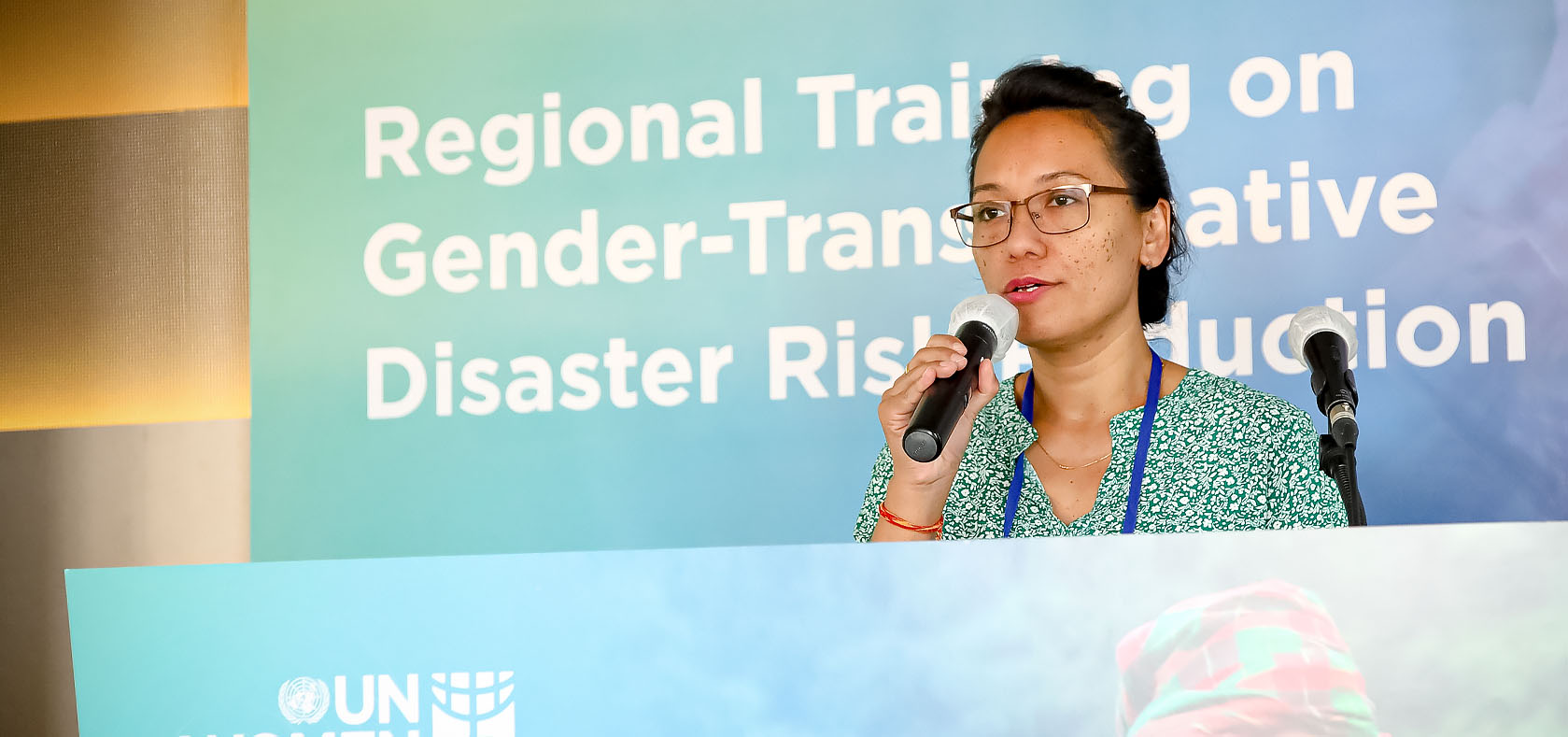Take Five: “We cannot take a blanket approach when responding to disasters. Our response must be tailored to the specific needs of different sections or groups within a community.”
Date:
Interviewed by: Trisha Albay
Shakti Gurung is a Member Secretary and Task Team at the Women Humanitarian and DRR (Disaster Risk Reduction) Platform (WHDRRP) in Nepal. WHDRRP is a national meeting point for women in disaster risk reduction, humanitarian response and climate change adaptation. Shakti participated in UN Women’s Regional Training on Gender-Transformative Disaster Risk Reduction in Seoul, Republic of Korea, where she related her experiences concerning harnessing at ground level the power of women-led organizations.

What has been the role of women-led organizations in Nepal in facilitating gender-transformative disaster risk reduction (DRR) on the ground?
In Nepal, women-led organizations play an important role in advocating for more gender-transformative DRR strategies and plans at the local level. Their initiatives also include gender sensitization for newly elected local government representatives.
At the national level, they organize dialogues with policymakers and other organizations to advocate for policies that address the specific needs of women and other vulnerable groups.
Women-led groups are also key actors during disaster response. My platform, for instance, works across 6-7 districts with allied organizations. We fundraise and distribute financial support and non-food items to the most vulnerable. We also support data collection for risk assessment.
What are some of the key advantages that women-led organizations bring to the table?
Women-led organizations work for different groups – indigenous women, women with disabilities, LGBTIQ+ people and many others. Women-led organizations serve as powerful advocates and representatives giving voice to the concerns of marginalized groups. These organizations understand the unique challenges, needs and aspirations of such marginalized communities, and they play a vital role in bridging the gap between policymakers and urgent grassroots needs.
Women-led organizations also give value to collaboration and solidarity in disaster response. We pool our resources, expertise and networks to mount more effective and comprehensive disaster response efforts.
What progress have you witnessed in Nepal in advancing gender-transformative DRR?
Several progressive DRR activities in Nepal are underway, and women-led organizations are playing a vital role. A mark of our significant progress is that women-led organizations are now regularly invited by the National Disaster Risk Reduction and Management Authority (NDRRMA) to join in strategizing and planning related to Gender Equality, Disability and Social Inclusion (GEDSI).
Women-led organizations are also working more collaboratively with local governments to respond to disasters. In 2021, as an example, there were numerous floods and landslides in Nepal. Our Platform coordinated with deputy mayors and vice chairpersons spread across more than six districts in raising funds and providing monetary support to women-headed households.
What actions are needed to support vulnerable groups, especially women and girls, who are disproportionately impacted by disasters?
We cannot take a blanket approach when responding to disasters. Our response must be tailored to the specific needs of different sectors or groups within a community.
The government must ensure the collection of Sex, Age and Disability Disaggregated Data (SADDD) and strengthen their data management system so that when any kind of disaster occurs, they can address key needs, concerns, and priorities. Future responses can then be targeted to specific communities.
These surveys should also ensure the meaningful participation of women from different backgrounds in risk assessment. Risk assessment should not miss out on other vulnerable groups so their needs are reflected in DRR policies and plans.
What can we do to engage more women in efforts to make disaster risk reduction more gender-transformative?
Engaging women in all phases of disaster risk reduction should be mandatory. In the past, many women did not attend DRR discussions in fear that DDR required a technical background, thus missing out on participation in decision-making. Some women may lack basic familiarity with the contingencies during disasters, especially those from the grassroots level. They may not be able to properly identify the risks they face or their coping capacities. It is important to enhance their preparedness for disasters and emergencies, so they feel more empowered to speak up, join community-level committees and participate more meaningfully during risk assessments.
It is also important, beginning with each household, to increase readiness and preparedness for all types of disasters communities face.